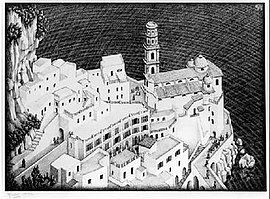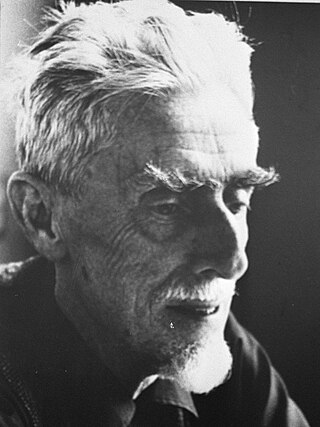
Maurits Cornelis Escher was a Dutch graphic artist who made woodcuts, lithographs, and mezzotints, many of which were inspired by mathematics. Despite wide popular interest, for most of his life Escher was neglected in the art world, even in his native Netherlands. He was 70 before a retrospective exhibition was held. In the late twentieth century, he became more widely appreciated, and in the twenty-first century he has been celebrated in exhibitions around the world.
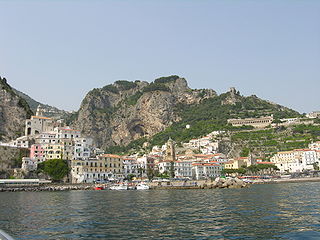
Amalfi is a town and comune in the province of Salerno, in the region of Campania, Italy, on the Gulf of Salerno. It lies at the mouth of a deep ravine, at the foot of Monte Cerreto, surrounded by dramatic cliffs and coastal scenery. The town of Amalfi was the capital of the maritime republic known as the Duchy of Amalfi, an important trading power in the Mediterranean between 839 and around 1200.

The Amalfi Coast is a stretch of coastline in southern Italy overlooking the Tyrrhenian Sea and the Gulf of Salerno. It is located south of the Sorrentine Peninsula and north of the Cilentan Coast.

Castrovalva is a lithograph print by the Dutch artist M. C. Escher, first printed in February 1930. Like many of Escher's early works, it depicts a place that he visited on a tour of Italy.
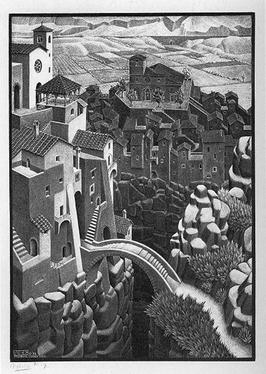
The Bridge is a lithograph print by the Dutch artist M. C. Escher, first printed in March 1930.

Still Life and Street is an unusual woodcut print by the Dutch artist M. C. Escher which was first printed in March, 1937. It was his first print of an impossible reality. In this artwork there are two distinctly recognizable realities bound together in a natural yet impossible way. Looked at from the window, the houses make book-rests between which tiny dolls are set up. Looked at from the street, the books stand yards high and a gigantic tobacco jar stands at the crossroads.
Metamorphosis I is a woodcut print by the Dutch artist M. C. Escher which was first printed in May, 1937. This piece measures 19.5 cm × 90.8 cm and is printed on two sheets.

Metamorphosis II is a woodcut print by the Dutch artist M. C. Escher. It was created between November, 1939 and March, 1940. The print measures 19.2 by 389.5 centimetres and was printed from 20 blocks on 3 combined sheets. Metamorphosis II is a long, horizontal piece which depicts animals and other forms gradually transforming into each other.

Metamorphosis III is a woodcut print by the Dutch artist M. C. Escher created during 1967 and 1968. Measuring 19 cm × 680 cm, this is Escher's largest print. It was printed on thirty-three blocks on six combined sheets.

Ravello is a comune (municipality) situated above the Amalfi Coast, in the province of Salerno, Campania, with approximately 2,500 inhabitants. Its scenic location makes it a popular tourist destination, and earned it a listing as a UNESCO World Heritage Site in 1997.

In geometry, the rhombille tiling, also known as tumbling blocks, reversible cubes, or the dice lattice, is a tessellation of identical 60° rhombi on the Euclidean plane. Each rhombus has two 60° and two 120° angles; rhombi with this shape are sometimes also called diamonds. Sets of three rhombi meet at their 120° angles, and sets of six rhombi meet at their 60° angles.

The Duchy of Amalfi or the Republic of Amalfi was a de facto independent state centered on the Southern Italian city of Amalfi during the 10th and 11th centuries. The city and its territory were originally part of the larger ducatus Neapolitanus, governed by a patrician, but it extracted itself from Byzantine vassalage and first elected a duke in 958.

Escher in Het Paleis is a museum in The Hague, Netherlands, featuring the works of the Dutch graphical artist M. C. Escher. It is housed in the Lange Voorhout Palace since November 2002.

Goriano Sicoli is a comune and town in the Province of L'Aquila in the Abruzzo region of Italy.

Atrani is a city and comune on the Amalfi Coast in the province of Salerno in the Campania region of south-western Italy. It is located to the east of Amalfi, several minutes' drive down the coast.

Scala is a town and comune in the province of Salerno in the Campania region of south-western Italy. It is located on a rocky hill c. 400 m above sea-level and is part of the Amalfi Coast.

The Chiesa di San Giovanni del Toro is a church in Ravello, southern Italy.
The Dragone is a river of the Amalfi Coast, Italy. It cuts through the Jurassic limestone of the area and emerges at the historic town and beach resort of Atrani.

Print Gallery is a lithograph printed in 1956 by the Dutch artist M. C. Escher. It depicts a man in a gallery viewing a print of a seaport, and among the buildings in the seaport is the very gallery in which he is standing, making use of the Droste effect with visual recursion. The lithograph has attracted discussion in both mathematical and artistic contexts. Escher considered Print Gallery to be among the best of his works.
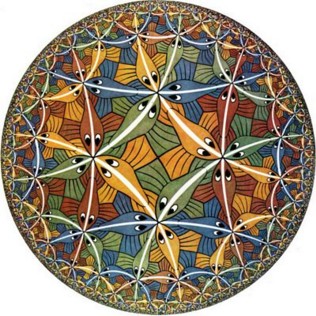
Circle Limit III is a woodcut made in 1959 by Dutch artist M. C. Escher, in which "strings of fish shoot up like rockets from infinitely far away" and then "fall back again whence they came".
